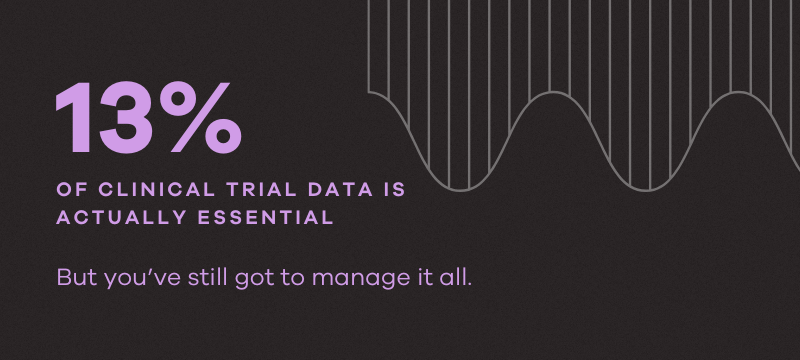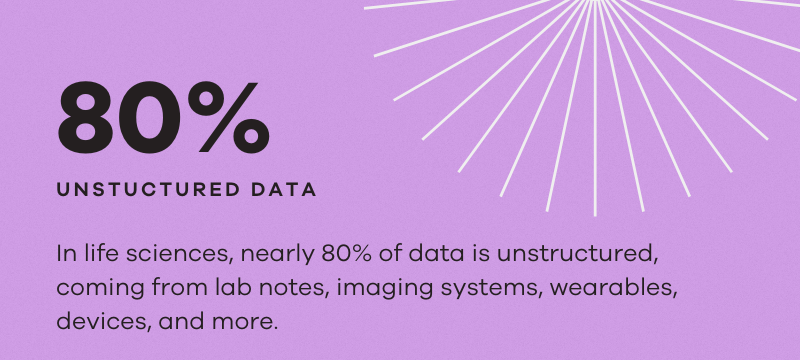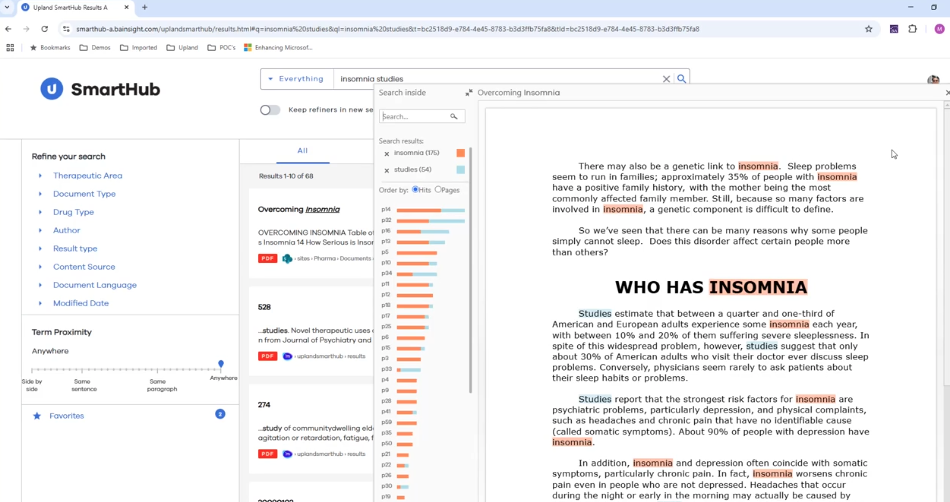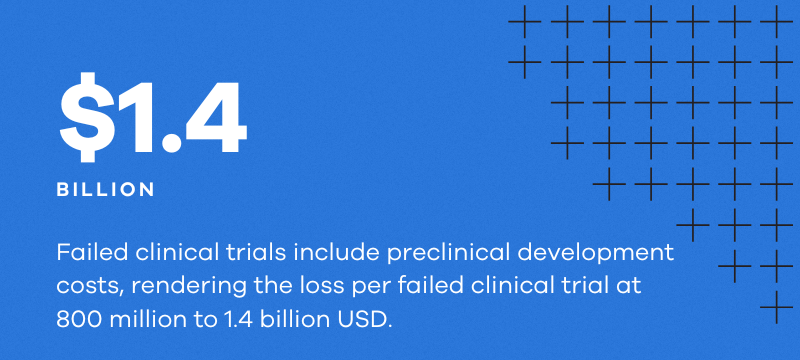The search for life sciences data is broken. Teams wade through EHRs, CRFs, lab notes, wearables, and regulatory files, where data is scattered, duplicated, or locked in silos they can’t search.
This slows everything down. It already takes about ten years and $1.4 billion to bring a single drug to market, with 80% of that cost tied to clinical development. Meanwhile, trials are getting more complex, with data coming from every direction.
Disconnected systems can’t keep up. With no easy way to filter or search, teams deal with far more data than necessary. One study found that just 13% of clinical trial data is actually essential.

That’s where AI-powered search comes in. It helps teams find the right information faster, connect systems, and better use the data they already have.
Why Life Sciences Data Is So Hard to Manage
Data is only as good as what you can do with it. When fragmented across systems or buried in the wrong format, it holds teams back instead of moving research forward. Here’s why the search for life sciences data remains a significant challenge.
Everyone’s Using Different Systems

In life sciences, nearly 80% of data is unstructured. It comes from lab notes, imaging systems, wearables, and devices. That makes it hard to connect or analyze. As a result, the search for life sciences data is slow and unreliable. Most of it sits in disconnected systems. They’re buried in silos teams can’t easily access. The challenges include:
- Data living across lab systems, PDFs, imaging tools, and wearables, all formatted differently
- Most tools don’t integrate, so there’s no way to get a single view of the data
Researchers spend hours trying to organize data instead of acting on it. Unsurprisingly, 52% of R&D leaders say integration is one of the biggest barriers to digital transformation. Critical insights stay buried when systems don’t talk to each other. The consequence? Progress slows down.
Forms and Repositories Don’t Work Together
It’s not just the systems that don’t align. The way data is collected and stored can also hold teams back. Many teams still reuse CRF templates without updating them for new protocols. Data quality takes a hit when the study evolves but the form doesn’t.. You get mismatched fields, missing information, and more cleanup work.
Global trials add another layer of complexity. Even when CRFs collect the same type of data, they’re often structured differently by team or region. That makes it harder to merge, compare, or analyze across studies. Common struggles include:
- CRFs that don’t reflect protocol updates
- Inconsistent structures that block collaboration
- Clean data becomes harder to use over time
Even when the forms are accurate, they often land in disconnected systems like SharePoint, OpenText Documentum, or Veeva Vault. Without a way to search for life sciences data across those repositories, researchers waste time tracking down documents. And that can result in more concerns, like:
- Repositories are siloed and can’t be searched together
- Key documents get buried or missed
- Trial timelines slow as teams search for data
Instead of getting buried in data, teams should be able to find what they need and keep moving.
Important Data Gets Overlooked
The same drug can show up under different names, a brand, a chemical name, or even an internal code. Acetaminophen, for example, might also appear as N-acetyl-p-aminophenol or Tylenol. Without smarter search tools, it’s easy to miss those connections. That means teams can overlook useful data. It also means they need to repeat work or miss patterns that matter.
AI search changes that. Instead of relying on exact keywords, it understands the intent behind queries. It connects content across siloed systems and identifies terms that mean the same thing, even if they’re spelled differently or buried in scanned documents.
What Modern Search Looks Like in Life Sciences
Our search capabilities at BA Insight have come a long way. We started out by building an enterprise search tool that let teams search company data the same way they use Google. In life sciences, that meant helping researchers quickly find critical information across disconnected systems to support faster drug development.
But once generative AI entered the picture, expectations changed. Teams wanted more than just documents, they needed smarter ways to use their data. So we expanded into AI enablement to support that shift.

However, AI search is still at the heart of it all today. It’s what makes everything with AI possible. When researchers can find what they need, they can act faster, avoid rework, and move promising treatments forward.
To deliver on that promise, we understand that search needs to work at the enterprise level, especially in high-stakes fields like life sciences.
What Enterprise Life Sciences Teams Need from Search
You need more than speed to make smart decisions in life sciences. Search needs to be built for scale. It also needs to:
- Be able to search across systems: Researchers need to pull results from places like Veeva Vault, Documentum, and Box without switching platforms.
- Have compliance built in: Search should support FDA guidelines and regulatory frameworks to help reduce risk and avoid delays.
- Deliver results that fit each user: Search should reflect the person’s role, clinical trials, regulatory affairs, or R&D, and surface what matters most to their work.
- Use smart tagging and structure: Metadata enrichment, augmentation, and taxonomy support help add context, improve accuracy, and ensure the right content shows up when it’s needed.
- Make it easier to share and find knowledge: Quick access to shared knowledge helps teams avoid duplicate work and make faster decisions.
- Enhance user experiences: A clean design and intuitive filters help more people actually use it, without extra training or frustration.
- Prioritize security: While information should be accessible, security needs to stay front and center to support enterprise-level growth.
BA Insight checks all these boxes. Its search capabilities are built for life sciences, with on-premise deployment and security trimming that many teams still count on for peace of mind. That means researchers get faster and safer access to the right data.
How AI Search Solves the Problem
Search for life sciences needs more than basic indexing. Without clean, connected data, most AI projects stall. If you’re comparing Sinequa alternatives, look beyond speed. The right solution does more. Let’s take a look.
AI Search Supports Smarter Clinical Trial Decisions
One missed data point can derail a clinical trial. With millions on the line, teams need clearer access to the full picture, from structured trial databases to handwritten CRFs and scanned documents.
The challenge is that a lot of valuable trial data never makes it past publication. Participant-level data and metadata often stay siloed or locked away. But that’s starting to shift. More organizations are now exploring ways to share detailed clinical trial data more responsibly, to help others build on past work and make smarter decisions going forward.
AI-powered search tools like BA Insight make that data usable. They surface relevant information in real time, cut through noise, and help teams identify what matters early. This can:
- Improve triage
- Speed up go/no-go decisions
- Reduce the risk of costly errors
- Simplify search for life sciences data
Real-world evidence backs this up. In a study of over 61,000 lung cancer patients, broadening eligibility criteria doubled the pool of trial-eligible participants without compromising outcomes. This speaks volumes about how accessible, well-managed data can directly influence trial success.
AI also helps reduce trial failures by improving patient selection, recruitment, and monitoring, areas that often lead to losses between $800 million and $1.4 billion. With clearer data, teams can move faster and make smarter decisions.
AI Search Builds Smarter Research Pipelines
Fast growth can be a double-edged sword. It drives momentum. But it also creates massive volumes of data. During COVID, AI adoption picked up speed, especially in areas like drug development, diagnostics, and genomics. That shift raised the bar for how quickly teams are expected to move.

Now, a typical Phase III trial generates 3.6 million data points. That’s three times more than it was ten years ago. Add early discovery, screening, and lab data, and the volume gets overwhelming fast.
With all that growth comes complexity and cost. Expanding lab space, growing headcount, and handling huge amounts of information all put pressure on teams. They need faster, more reliable access to the data that drives research forward, without wasting time or resources.
AI search helps make that possible. It cuts through scattered systems and surfaces the information researchers need to keep moving. It also shortens the time between early discovery and clinical development by improving access to critical data.
AI Search Breaks Down Silos
Disconnected systems and fragmented data slow everything down in life sciences. Outdated platforms, proprietary formats, and strict regulations create silos that block visibility. Teams can’t access the full picture, and AI tools struggle to work with incomplete or inconsistent data.
AI search makes it easier to work across those silos. It connects systems, organizes unstructured content, and gives researchers access to the information they need, when they need it. That means:
- Easier access to both internal and external data
- Better visibility across disconnected platforms
- Less wasted time switching between systems
When teams can actually find what they’re looking for, they can move faster and stay focused on the work that matters.
AI Search Is the First Step to Smarter R&D
Good science depends on findable data. But in life sciences, too much of it still disappears into disconnected systems. That means teams end up chasing data instead of moving research forward.
Leaders know it too. PwC found that most pharma execs admit they don’t have the access they need, and it’s getting in the way of innovation. AI search gives life sciences teams a way to break that pattern and change course.
BA Insight’s AI Search solution gives your data a voice. If you’re looking for a Sinequa alternative, BA Insight offers a faster, simpler way for life sciences teams to find what they need. It surfaces what matters and gets it in front of the people who can act on it. Start making your data work like it should. Book a demo today.


